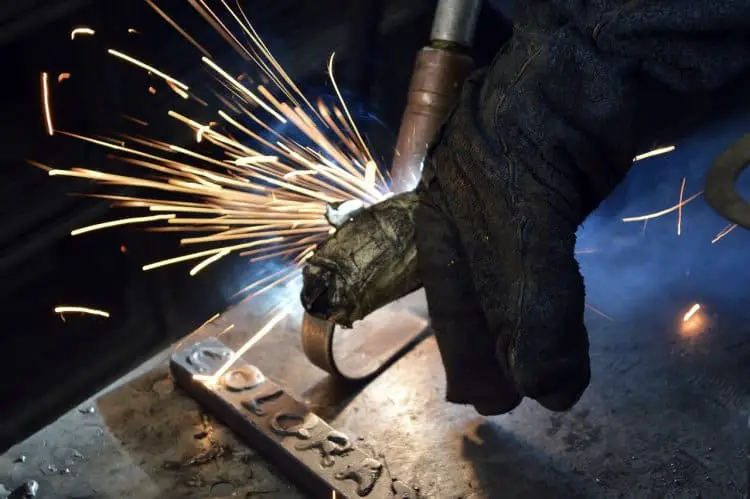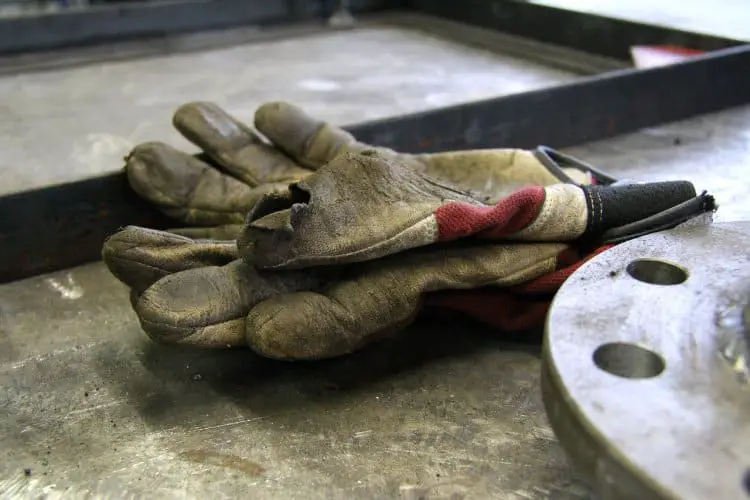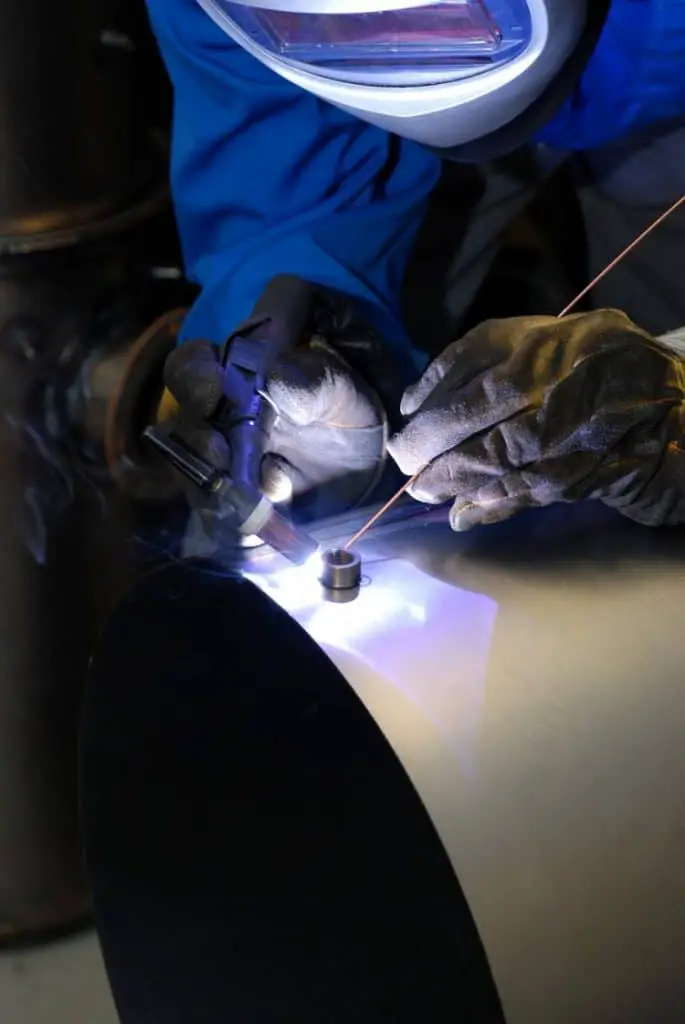This post contains affiliate links to products, services, or education. We may receive a commission for purchases made through links.
For jobs that are surrounded by extreme heat, infrared radiation, ultraviolet rays, and electricity, welding gloves can protect your hands and arms from serious burns. These gloves range in material and type, which can provide the user with different heat resistance for different jobs. It’s important to know what kind of welding gloves you will need for your next job.
Are welding gloves heat resistant? Welding gloves can withstand temperatures of 2000°F for short periods. For longer hold times, these gloves can handle a temperature of 600°F. Heat resistance can vary depending on the material of welding gloves.

According to the U.S. Bureau of Labor Statistics, 14,120 employees received thermal burns in 2014 and required time away from work.
These injuries typically occur when incorrect personal protective equipment is being used. To better protect yourself from burns, consider the type of material you are using during the job.
Different materials, both exterior, and interior will change how the heat reaches you.
Types of Material Used for Welding Gloves
TL/DR: Check out our recommended welding gloves here.
Welding glove materials can vary, both inside and out. The exterior typically focuses on protection and coverage, while the interior focuses on comfort and dexterity. No matter what material, both the interior and exterior should be heat resistant.
Exterior Materials for Welding Gloves
Leather Welding Gloves
The most popular exterior material for welding gloves is natural leather, and there are various types. There are different properties to each type of leather, as it comes from different animals.
In general, leather is known for its durability and ability to diminish heat. Here are some types of leather and their differences:
- Cowhide– Resistant to abrasions and is very durable
- Deerskin– Very soft, provides all-day comfort with great sensitivity
- Pigskin– Durable due to its porous texture
- Goatskin– Considered a stronger and more durable leather
- Calfskin– Not as durable as cowhide, but is more maneuverable

Kevlar Welding Gloves
Another popular material for both the exterior and interior of welding gloves is Kevlar. This synthetic fiber not only is extremely heat resistant, but it is also cut resistant.
On top of that, they will not melt.
Kevlar is such a strong material, with enough of it you can stop a bullet. It would be almost shocking to find out this material is also flexible, comfortable and lightweight.
But it is – and that is why it is often used for body armor.
Terry Knit
If your job requires more dexterity than heat resistance, then try terrycloth. This fabric can only withstand temperatures near 250 degrees, but it is much easier to use your hands with these gloves.
These gloves also provide much more insulation compared to the previous two materials.
Insulated loops are cut and sewn together to create a more breathable material. This is very important if you work in a hot environment, rather than with hot materials.
Other Materials for Welding Gloves
Those aren’t the only fibers and fabrics used for welding gloves. Different industries can benefit from different materials. Here are some other options for making welding gloves:
- Aluminized- Reflective material protects against radiant heat and molten splash
- Carbon Fiber– Can temporarily withstand temperatures above 2000°F
- Nomex– Resistant against high burning temperatures and will not melt
- Polybenzimidazole (PBI)- High-tech fiber that will not melt, drip, or burn
- Wool– Used as a liner for its comfort and basic heat resistance
- Zetex– A texturized silica yarn that can withstand temperatures of 2000°F
Interior Fabrics for Welding Gloves
You will likely find the same material used on the outside of the welding gloves inside as well. If not, the interior will be a more comfortable material that is also heat resistant, such as pile or wool.
Occasionally the interior will be a combination of these materials:
- Foam– Lightweight and provides air barrier protection, creating a cushion effect
- Kevlar– As mentioned, this material is cut and heat resistant, versatile, and strong
- Jersey– This is the most economical option for heat protection
- Thinsulate- Considered the leading materials for insulation
- Pile– A soft cotton blend that is very comfortable
- Thermosock– High loft matte fiber that is also soft
- Wool- Best natural material for insulation. It also dries very quickly
Things to Consider When Choosing Welding Gloves

If welding gloves are something you need to invest in, then there are several things to consider when choosing the right pair. Consider these two things:
- What kind of job you are working, and the degree of heat that you will be near
- If you need additional protection from other risks, such as electricity or sharp objects
Once you’ve figured out the type of welding gloves you need, it’s time to consider three very important factors.
Protection
What are you protecting and from what? Maybe you need hand pads to move one hot object somewhere else very quickly. Or you might need to cover your entire forearm because you’re around sparks from welding. If you work in a hot environment or with hot materials, you might want to consider buying welding gloves with good insulation.
Dexterity
How much movement do you need to perform your job? Typically, the hotter the work being handled, the thicker the glove. If dexterity is crucial to your job, then consider that. Women’s welding gloves are often made for a smaller hand, giving them a little more dexterity. The ability to use your hands with gloves on can greatly increase your productivity by not having to constantly put them on and off.
Longevity
The last thing to consider when buying welding gloves is how long you will be using them. As with almost anything, the more you spend will determine the quality of gloves, and how long they will last. If you are constantly around heat or electricity, then you might want to invest in a better-quality pair. On the other hand, if you only need to protect your body from thermal injury a couple of times a year, then consider buying hand pads instead of welding gloves.
Other Types of Protective Gloves for Hot Jobs
While welding gloves are often the most common gloves for welders (and help prevent injury to you while welding), there are many other options to consider. Different industries will require different types of gloves, depending on the type of work being done.
Hot mill and heat gloves offer similar protection as welding gloves, but offer other benefits, like comfort. Hand pads are similar to these gloves but are limited in their practicality.
Understanding these alternatives will help you know which pair of gloves will be best for your situation.
- Heat/Flame Gloves: Heat/ flame gloves can withstand the same amount of heat as welding gloves, but often sacrifice dexterity. These are great for all types of heat and will cover your fingers, hands, wrist, and forearm. Unfortunately, these gloves make it very difficult to use your hands for additional tasks.
- Hot Mill Gloves: Hot mill gloves are great for temporary heat handling. These gloves contain layers of cotton or blended fabric that are sewn together. They are not to be used near open fires but still provide enough protection to hold hot items. These gloves typically cover the same region as the previously mentioned gloves.
- Hand Pads: These are the only options that aren’t considered gloves. Hand pads look like all of the previously mentioned gloves, but don’t have fingertip protection and don’t cover the wrist. In other words, hand pads are more practical for minor heat exposure that will only be in contact with your palms.
On the other hand, the lack of fingertips makes this option reversible, improving durability and longevity. These would be perfect for someone who goes back and forth between writing and working near hot materials.
